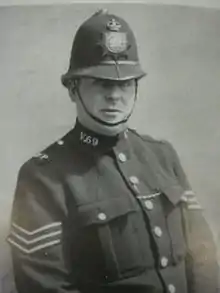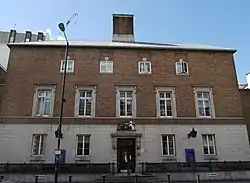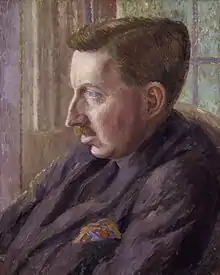Harry Daley
Sergeant Harry Daley (14 November 1901 – 1971) was the first openly gay British policeman. Born in Lowestoft he later moved to Dorking and, in 1925, to London where he joined the Metropolitan Police. Soon after joining the police, he met gay writer J. R. Ackerley and, through him, a number of other literary and artistic figures. Daley became the lover of writer E. M. Forster at the age of 25, a relationship that lasted seven years. After retiring from the police in 1950 he returned to Dorking where he lived with his brother and his partner. Daley wrote an autobiography that was published posthumously in 1986.

Early life
Harry Daley was born in Lowestoft, Suffolk on 14 November 1901, the second youngest of five children.[1] His father, Joseph Daley, was an orphan born in Poplar, London, who became the skipper of a fishing smack; his mother was Emily née Firman, a former parlourmaid.[1][2][3] From the age of three Harry Daley was educated at the local school and when he was nine-years-old his father died at sea in a storm. Because of this Daley decided to help support his family by becoming a telegram boy rather than attending secondary school.[1] During the First World War, his mother, fearing Zeppelin raids and a German invasion, moved the family to Dorking in 1916 and Daley found work as a grocer's delivery boy.[4][1] Daley's sole elder brother was killed while serving in the Machine Gun Corps on the Western Front on 7 November 1918, just days before the end of the war.[5]
While living at Dorking, Daley was fascinated by London and spent his weekends in the capital's theatres, cinemas, galleries and concert halls.[4] He was also an avid reader and bought quantities of cheap books from second-hand shops.[1] Daley recognised he was a homosexual during his childhood and referred to his sexuality as a "small cloud" that followed him.[6]
Police career
Hammersmith

Daley moved to London and applied to join the Metropolitan Police in 1925, starting his training at Peel House in March.[1][7] Daley's first posting was to a station in Chiswick but he was soon moved to Hammersmith.[1][7] At Hammersmith, Daley considered that the constables were under pressure to carry out arrests and issue summons. This resulted in many people being stopped and searched without suspicion, which Daley thought antagonised drunk members of the public and led to the arrest of persons in marginal cases such as workmen carrying home materials left-over from building sites.[8] He stated that the policemen in Hammersmith augmented their wages by receiving bribes from bookmakers on their beat to "look the other way".[9] Constables could receive a half crown (2.5 shillings) a day from each bookmaker at a time when weekly wages for a constable with two years service was £3 6s (66 shillings).[9][10] Daley recalled collecting the half crown from the bookmaker on his beat from a window ledge. He also remembered receiving complaints when he took a day off and his replacement did not accept the bribe.[11] Daley also described making more than 30 shillings in one day by helping motorists to park at the Olympia London exhibition centre, though a portion was passed on to his sergeant and the clerk at the police station.[11][10] Daley considered that corruption decreased after the appointment of Lord Trenchard as commissioner in 1931: "when our superior officer were known to be honest, the majority of us followed suit".[10]

Soon after joining the police Daley met the gay writer J. R. Ackerley. Daley had seen Ackerley's The Prisoners of War at the Lyric Theatre, Hammersmith, and was intrigued by its homosexual theme;[nb 1] while walking his beat. Daley made the acquaintance of the writer one day when Ackerly was fetching the milk from his doorstep.[4] The pair probably had a brief sexual relationship and remained lifelong friends afterwards.[1] Through Ackerley, Daley came into contact with a wider circle of writers and artists, including those of the Bloomsbury Group, whose member Duncan Grant painted a portrait of Daley in 1930.[7][4] By the age of 25 Daley had become a lover of the writer E. M. Forster, a relationship that lasted for seven years.[3][15] P. N. Furbank's 1978 biography of Forster notes that Daley was "plump, curly-haired, genial and rather cocky in manner: very intelligent, with a taste for music and opera, and a brilliant raconteur. He was homosexual and made no secret of it; indeed he was wildly indiscreet. His closest friends, and lovers, were mainly criminals."[4] During this time Forster often accompanied Daley on his beat and Daley introduced him to a number of his working-class acquaintances.[1] Forster considered that Daley was too indiscreet and friendly with criminals and ended their relationship in 1932.[4]
Daley was a keen amateur photographer and took photographs of some of the men he arrested, which included some of his lovers. The men were generally happy to pose for him, often doing so as they were escorted into black Marias.[1] Daley was openly gay at a time when male homosexual activity was illegal in Britain and was the first openly gay British policeman.[3] Daley was the subject of some discrimination from his colleagues, including offensive graffiti, though he regarded them as largely tolerant.[16][4] He was a popular character with his colleagues and the public, which may have helped him to become accepted.[3] His police colleagues apparently considered Daley different from the men they regularly arrested for homosexual soliciting.[3]
In 1929 Daley was selected by Ackerley, in his role as a BBC radio producer, to give a series of talks about his police service.[4] These talks, which were broadcast on shows including Children's Hour and While London Sleeps, may have helped inspire Ted Willis's 1955–76 television series Dixon of Dock Green.[3][4] Some of Daley's talks, including "Not a Happy One?", broadcast on the Home Service on 25 March 1929, were published as articles in The Listener. Some broadcasts were made under his real name and others, particularly his accounts of criminal activities in London's street markets, under the pseudonyms of Jope Daley or Harry Firman.[1]
Later career

In 1935, Daley was transferred to the station on Vine Street in Westminster.[1][17] He observed the station officers maintained good relations with the West End prostitutes but that otherwise police corruption had markedly decreased in the area after a 1929 scandal.[18] Daley, who was disgusted by fascism, noted that some of the younger constables were uniformed members of the British Union of Fascists and took part in distributing anti-Jewish propaganda.[19][17] Daley recalled that during the Second World War the Vine Street officers were helped by Mrs Fisher, the Jewish wife of a local publican and in return they invited the Fishers to make use of the station's reinforced air raid shelter. Some of the blackshirt constables objected to this and Daley made himself unpopular by confronting them.[4]
Daley's duties included responding to bomb explosions during The Blitz. He moved to Wandsworth station in 1941, by which time he had been promoted to the rank of sergeant.[4] During the war Daley wrote several short stories that he submitted to Ackerley, who was then the literary editor of The Listener; these were refused publication because they were judged to be "rather near the knuckle".[1] After the war Daley was put on temporary staff duties, running a police recruitment centre on Beak Street, Soho. He found that he missed walking the beat and retired from the police on 21 May 1950.[3][1]
Later life and legacy
After retirement Daley spent some time as a master-at-arms in the merchant navy, but this career was cut short by a diagnosis of diabetes.[1][4] In 1957 Daley retired to Dorking where he shared a home with his younger brother, David, and his brother's long-term partner, John.[1][3] He died at home in 1971, was cremated in Worth, West Sussex, and his ashes were scattered on Box Hill.[1][4][3] On Ackerley's advice, Daley had written an autobiography that was posthumously published, as This Small Cloud, in 1987.[20][21] Because Daley fell out with Forster, his autobiography makes no mention of the writer or of Daley's Bloomsbury Group friends.[4] Daley destroyed all his other written records before his death, leaving an estate worth £803.[1]
A building connected to Daley was nominated for a blue plaque in 2017 but the application was declined by English Heritage, who did not consider him to be sufficiently historically significant; he cannot be re-nominated until 2027.[nb 2] A chapter of Stephen Bourne's 2017 book, Fighting Proud: The Untold Story Of The Gay Men Who Served In Two World Wars, is about Daley.[3]
Notes
- The Prisoners of War was first performed to the members-only 300 Club in 1925 but was soon granted a license to be performed at the Playhouse Theatre in London's West End.[12] It depicts the unrequited love of an army captain for a fellow officer in a prisoner of war camp.[13] The Prisoners of War was the first 20th-century play put on in the West End or Broadway to deal with homosexual desire.[12] Its premise thought to have slipped past the Lord Chamberlain, who was responsible for censoring plays in this period.[14]
- English Heritage administers the Blue Plaque Scheme within Greater London, it has erected 950 plaques on buildings linked to historic figures.[22] Candidates must be approved by a panel of experts and meet a number of criteria, including historical significance. English Heritage describe the approval process as "highly selective".[23]
References
- "Daley, Harry". Oxford Dictionary of National Biography (online ed.). Oxford University Press. doi:10.1093/ref:odnb/60647. (Subscription or UK public library membership required.)
- New Society. New Society Limited. 1987. p. 29.
- France, Anthony (19 February 2021). "'Honour Met's first gay policeman with blue plaque,' say campaigners". London Evening Standard. Retrieved 12 April 2021.
- Bourne, Stephen (1 December 2019). "A Gay PC – When Being Gay Wasn't PC". The Oldie. Retrieved 13 April 2021.
- "Private J Daley". Commonwealth War Graves Commission. Retrieved 13 April 2021.
- Country Life. Country Life, Limited. 1987. p. 158.
- Burton, Peter (1995). Amongst the Aliens: Some Aspects of a Gay Life. Millivres. p. 105. ISBN 978-1-873741-21-4.
- McLaughlin, Eugene; Muncie, John (2001). Controlling Crime. SAGE Publications. p. 30. ISBN 978-0-7619-6973-0.
- Emsley, Clive (2009). The Great British Bobby: A History of British Policing from the 18th Century to the Present. Penguin Group. p. 217. ISBN 978-1-84724-947-0.
- White, Jerry (2008). London in the Twentieth Century: A City and Its People. Vintage. p. 289. ISBN 978-1-84595-126-9.
- Weinberger, Barbara (2016). The Best Police in the World: An Oral History of English Policing from the 1930s to the 1960s. Routledge. p. 163. ISBN 978-1-351-89407-4.
- Jongh, Nicholas de (26 March 1992). Not in Front of the Audience: Homosexuality On Stage. Routledge. p. 35. ISBN 978-1-134-96729-2.
- Dynes, Wayne R.; Grier, Barbara (1994). Gay & Lesbian Literature. St. James Press. p. 2. ISBN 978-1-55862-174-9.
- Theatre Record. I. Herbert. 1993. p. 115.
- Beauman, Nicola; Foster, Edward Morgan (1993). E. M. Forster: A Biography. A.A. Knopf. p. 346. ISBN 978-0-394-58381-5.
- Emsley, Clive (2021). A Short History of Police and Policing. Oxford: Oxford University Press. p. 211. ISBN 978-0-19-884460-0.
- Jones, David J. V. (1999). Crime, Protest and Police in Modern British Society: Essays in Memory of David J.V. Jones. University of Wales Press. p. 113. ISBN 978-0-7083-1555-2.
- Emsley, Clive (2014). The English Police: A Political and Social History. Routledge. p. 245. ISBN 978-1-317-89024-9.
- International review of social history. 2000. p. 108.
- The letters of J.R. Ackerley. 1975. p. 64. ISBN 978-0-7156-0642-1.
- Bourne, Stephen (2017). Fighting Proud: The Untold Story of the Gay Men Who Served in Two World Wars. Bloomsbury Publishing. p. 127. ISBN 978-1-78673-215-6.
- "Blue Plaques". English Heritage. Retrieved 17 July 2021.
- "Propose a Plaque". English Heritage. Retrieved 17 July 2021.